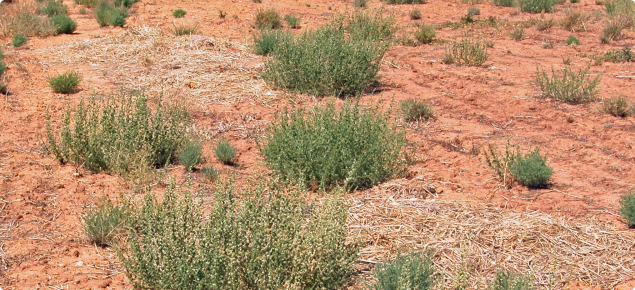Are your weeds under stress?
When using herbicides for weed management it is always best to apply the herbicide treatment when the weeds are young and actively growing and not under stress. Plants growing during the summer months can experience widely fluctuating temperatures, severe moisture stress and physical barriers such as dust can settle on the surface of the leaf - all of which can impact on how the weed is able to take up herbicides and the subsequent level of control.
Stressed weeds are harder to kill than healthy, actively growing weeds and might not show any distinct visual signs. Moisture stress is one of the most common plant stresses, especially in summer. Translocation and respiration slow dramatically when plants are moisture stressed, restricting the movement of herbicides to their sites of action. Flaxleaf fleabane, for example, can still be green and upright while under considerable moisture and temperature stress. The thick hairs on the leaves also add a barrier against herbicide absorption making fleabane very difficult to kill during the summer months.
If in doubt, wait until after rainfall. A reasonable rainfall will not only improve the moisture status of the plant but also remove dust from the leaves. Predicting a dose that will kill stressed weeds is difficult but if in doubt never ‘cut’ rates and consider the use of a double knockdown or a tillage operation as a follow-up.
Further information on how to determine if your weeds may be suffering from stress can be found at Factors affecting herbicide performance.
Do you need an additive to improve the effect of the herbicide?
High temperatures and low humidity can alter how long a droplet of herbicide lasts in the environment and this may impact on how much active chemical reaches the target plant. The addition of spray additives, oils and wetters, may alter the 'life-time' of a spray droplet and may also influence the penetration of the herbicide through the cuticle and into the plant.
Most herbicides will have a recommendation on the label should an additive be considered advantageous in certain spraying situations and it is best to consult the label prior to use. Remember, spray additives will only be of benefit while spraying under the correct conditions at the correct rates.
For further information on spraying refer to Summer weeds.
When is the best time to spray summer weeds?
Conditions during summer (hot, dry or humid) are not generally considered good conditions for applying herbicides. So it is often early in the morning or at night when the majority of spraying is done.
Spraying during the evening and night time can pose other challenges for the spray operator and is not recommended. It is illegal to spray under inversion conditions which usually occur one hour before sunset and one hour after sunrise.
When herbicides move away from the application site it is termed 'drift' and more information on the conditions that can contribute to spray drift and the situations to avoid when applying herbicide can be found at Herbicide drift.


